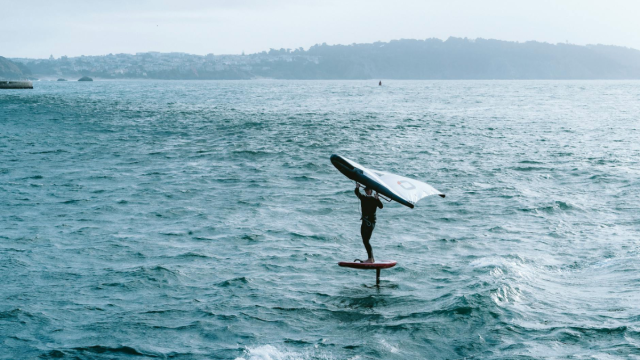Wingfoiling is taking over beaches around the world – and for good reason. Combining elements of windsurfing, kitesurfing, and foiling, this innovative sport offers a thrilling, yet accessible, water experience. Whether you’re chasing wind across open seas or carving quiet inland lakes, wingfoiling provides a unique sense of freedom. Here’s why you should consider giving it a try – and how to pick the right wingfoil gear to get started.
Why start wingfoiling?
Contents
1. Accessible for Beginners
Wingfoiling for beginners might seem intimidating, but it’s surprisingly beginner-friendly compared to other wind sports. With the right instruction and gear, most people can start riding within a few sessions. Unlike kitesurfing, wingfoiling doesn’t require complicated rigging or massive open spaces, making it easier to learn and safer overall.
2. Portable and Compact Equipment
Wingfoil equipment is far more compact than a windsurfing or kitesurfing setup. An inflatable wing and a lightweight foil board fit easily in most cars – no roof racks or trailers needed. This portability makes wingfoiling perfect for spontaneous sessions and travel.
3. Versatile Conditions
Wingfoiling works in a wide range of conditions – from 10 to 30 knots of wind – and it thrives on both flat water and small waves. That means more time on the water, even when the forecast isn’t perfect.
How to choose your wingfoil gear
Choosing the right gear is key to progressing quickly and safely. Here’s a breakdown of what to look for when shopping for your first setup:
1. Wingfoil Board
The wingfoil board is your base of operation. For beginners, go for a larger, more stable board – usually between 100 and 140 liters depending on your weight. More volume gives you better balance and helps you get up on the foil more easily.
2. Inflatable Wing
The inflatable wing is your power source. For newcomers, a wing between 4 and 5 square meters is ideal in moderate winds. Look for wings with good low-end power and a rigid frame to maintain shape and control.
3. Hydrofoil
The foil itself consists of a mast, fuselage, and wings. Beginners should look for a larger front wing (around 1500–2000 cm²) for early lift at lower speeds. Aluminum masts are a popular choice for their durability and affordability.
4. Wingfoil Shop Advice
Visit a dedicated wingfoil shop or talk to experienced riders before buying. Good retailers will assess your skill level, local conditions, and body weight to recommend the best wingfoil setup. Don’t just buy what looks cool – the right gear will make or break your learning curve.
Wingfoiling tips for beginners
- Take a lesson – Learning the basics from a certified instructor will save you hours of frustration.
- Start on flat water – Avoid waves until you’re comfortable with balance, pumping, and tacking.
- Watch the wind – Consistent side-onshore wind (not too strong) is best when starting out.
- Focus on foil control – Learn to balance on the board and gradually ease into lifting on the foil.
Wingfoil maintenance
Proper wingfoil maintenance helps protect your gear and prolong its life. Rinse all parts with fresh water after each session, especially if you ride in saltwater. Check for leaks or dings in your inflatable wing and inspect the foil bolts regularly. Store your wing out of the sun and in a cool, dry place.


